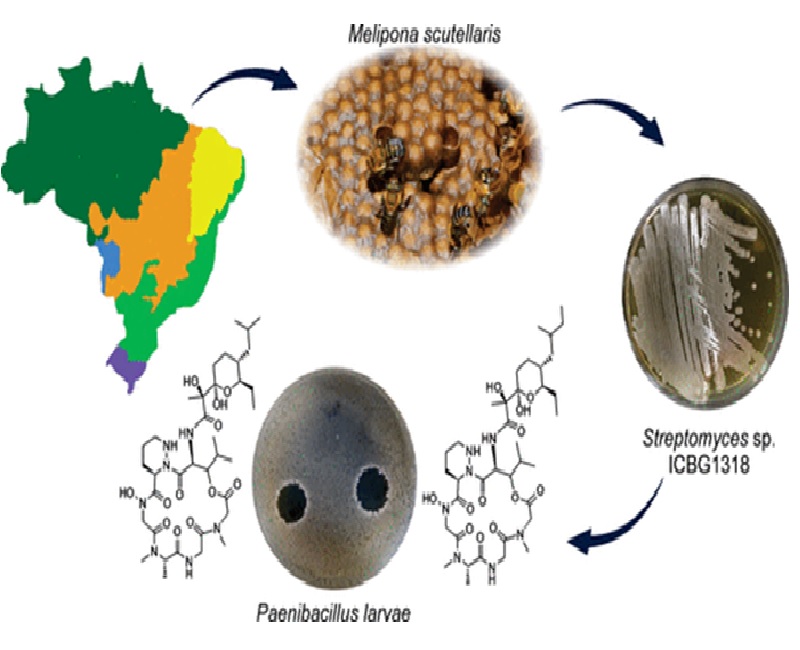
Authors:
Costa, Natalia C. S. [1, 2] ; Piccoli, Julia P. [2] ; Santos-Filho, Norival A. [2] ; Clementino, Leandro C. [2] ; Fusco-Almeida, Ana M. [2] ; De Annunzio, Sarah R. [2] ; Fontana, Carla R. [2] ; Verga, Juliane B. M. [2] ; Eto, Silas F. [3] ; Pizauro-Junior, Joao M. [3] ; Graminha, Marcia A. S. [2] ; Cilli, Eduardo M. [1]
Abstract:
Parasitic diseases are a neglected and serious problem, especially in underdeveloped countries. Among the major parasitic diseases, Leishmaniasis figures as an urgent challenge due to its high incidence and severity. At the same time, the indiscriminate use of antibiotics by the population is increasing together with resistance to medicines. To address this problem, new antibiotic-like molecules that directly kill or inhibit the growth of microorganisms are necessary, where antimicrobial peptides (AMPs) can be of great help. In this work, the ferrocene molecule, one active compound with low levels of in vivo toxicity, was coupled to the N-terminus of the RP1 peptide (derived from the human chemokine CXCL4), aiming to evaluate how this change modifies the structure, biological activity, and toxicity of the peptide. The peptide and the conjugate were synthesized using the solid phase peptide synthesis (SPPS). Circular dichroism assays in PBS showed that the RP1 peptide and its conjugate had a typical spectrum for disordered structures. The Fc-RP1 presented anti-amastigote activity against Leishmania amazonensis (IC50 = 0.25 mu mol L-1). In comparison with amphotericin B, a second-line drug approved for leishmaniasis treatment, (IC50 = 0.63 mu mol L-1), Fc-RP1 was more active and showed a 2.5-fold higher selectivity index. The RP1 peptide presented a MIC of 4.3 mu mol L-1 against S. agalactiae, whilst Fc-RP1 was four times more active (MIC = 0.96 mu mol L-1), indicating that ferrocene improved the antimicrobial activity against Gram-positive bacteria. The Fc-RP1 peptide also decreased the minimum inhibitory concentration (MIC) in the assays against E. faecalis (MIC = 7.9 mu mol L-1), E. coli (MIC = 3.9 mu mol L-1) and S. aureus (MIC = 3.9 mu mol L-1). The cytotoxicity of the compounds was tested against HaCaT cells, and no significant activity at the highest concentration tested (500 mu g. mL(-1)) was observed, showing the high potential of this new compound as a possible new drug. The coupling of ferrocene also increased the vesicle permeabilization of the peptide, showing a direct relation between high peptide concentration and high carboxy-fluorescein release, which indicates the action mechanism by pore formation on the vesicles. Several studies have shown that ferrocene destabilizes cell membranes through lipid peroxidation, leading to cell lysis. It is noteworthy that the Fc-RP1 peptide synthesized here is a prototype of a bioconjugation strategy, but it still is a compound with great biological activity against neglected and fish diseases.
1 Department of Biochemistry and Technological Chemistry, Institute of Chemistry, São Paulo State University (UNESP), Araraquara, Brazil
2 Department of Clinical Analysis, School of Pharmaceutical Sciences, São Paulo State University (UNESP), Araraquara, Brazil
3 Faculty of Agrarian and Veterinary Sciences, São Paulo State University (UNESP), Araraquara, Brazil
Link to article: https://journals.plos.org/plosone/article?id=10.1371/journal.pone.0228740







